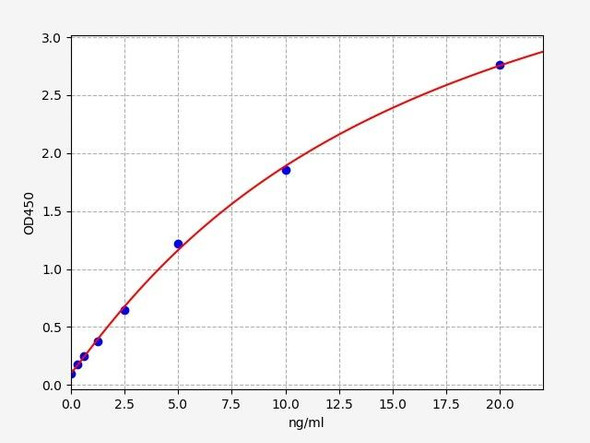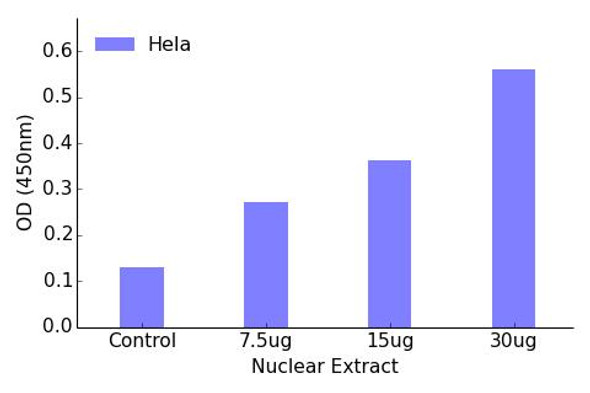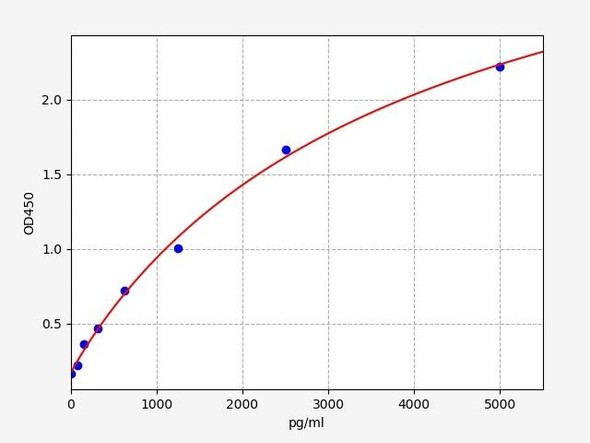Description
Human T-box transcription factor TBX1 (TBX1) ELISA Kit
The Human T-Box Transcription Factor TBX1 ELISA Kit is specifically designed for the precise quantification of TBX1 levels in human samples such as serum, plasma, and cell culture supernatants. With its high sensitivity and specificity, this ELISA kit ensures accurate and reproducible results, making it an invaluable tool for various research applications. TBX1 is a critical transcription factor involved in the development of multiple organ systems, particularly in the heart, thymus, and parathyroid glands. Mutations in the TBX1 gene are associated with several congenital disorders, including DiGeorge syndrome.
Understanding the role of TBX1 in development and disease pathogenesis is crucial for advancing our knowledge of these conditions and potentially developing targeted therapies. By utilizing the Human T-Box Transcription Factor TBX1 ELISA Kit, researchers can effectively study TBX1 expression levels and investigate its implications in various physiological and pathological processes. The kit's reliability and accuracy make it an excellent choice for laboratories conducting cutting-edge research in molecular biology and genetics.
| Product Name: | Human T-box transcription factor TBX1 (TBX1) ELISA Kit |
| SKU: | HUEB0641 |
| Size: | 96T |
| Target: | Human T-box transcription factor TBX1 (TBX1) |
| Synonyms: | Testis-specific T-box protein, T-box protein 1 |
| Assay Type: | Sandwich |
| Detection Method: | ELISA |
| Reactivity: | Human |
| Detection Range: | 0.312-20ng/mL |
| Sensitivity: | 0.098ng/mL |
| Intra CV: | 5.3% | ||||||||||||||||||||
| Inter CV: | 8.9% | ||||||||||||||||||||
| Linearity: |
| ||||||||||||||||||||
| Recovery: |
| ||||||||||||||||||||
| Function: | Probable transcriptional regulator involved in developmental processes. Is required for normal development of the pharyngeal arch arteries. |
| Uniprot: | O43435 |
| Sample Type: | Serum, plasma, tissue homogenates, cell culture supernates and other biological fluids |
| Specificity: | Natural and recombinant human T-box transcription factor TBX1 |
| Sub Unit: | Interacts with DSCR6. |
| Subcellular Location: | Nucleus |
| Storage: | Please see kit components below for exact storage details |
| Note: | For research use only |
| UniProt Protein Function: | TBX1: Probable transcriptional regulator involved in developmental processes. Is required for normal development of the pharyngeal arch arteries. Haploinsufficiency of the TBX1 gene is responsible for most of the physical malformations present in DiGeorge syndrome (DGS) and velocardiofacial syndrome (VCFS). DGS is characterized by the association of several malformations: hypoplastic thymus and parathyroid glands, congenital conotruncal cardiopathy, and a subtle but characteristic facial dysmorphology. VCFS is marked by the association of congenital conotruncal heart defects, cleft palate or velar insufficiency, facial dysmorpholgy and learning difficulties. It is now accepted that these two syndromes represent two forms of clinical expression of the same entity manifesting at different stages of life. Defects in TBX1 are a cause of DiGeorge syndrome (DGS). Defects in TBX1 are a cause of velocardiofacial syndrome (VCFS). Defects in TBX1 are a cause of conotruncal heart malformations (CTHM). CTHM consist of cardiac outflow tract defects, such as tetralogy of Fallot, pulmonary atresia, double-outlet right ventricle, truncus arteriosus communis, and aortic arch anomalies. 3 isoforms of the human protein are produced by alternative splicing. |
| UniProt Protein Details: | Protein type:DNA-binding; Transcription factor Chromosomal Location of Human Ortholog: 22q11.21 Cellular Component: nucleus Molecular Function:DNA binding; protein dimerization activity; protein homodimerization activity; sequence-specific DNA binding; transcription factor activity Biological Process: angiogenesis; anterior/posterior pattern formation; artery morphogenesis; blood vessel development; blood vessel morphogenesis; blood vessel remodeling; cell fate specification; cell proliferation; determination of left/right symmetry; ear morphogenesis; embryonic cranial skeleton morphogenesis; embryonic viscerocranium morphogenesis; epithelial cell differentiation; heart development; heart morphogenesis; inner ear morphogenesis; lymph vessel development; mesoderm development; middle ear morphogenesis; muscle cell fate commitment; muscle development; muscle morphogenesis; negative regulation of cell differentiation; neural crest cell migration; odontogenesis of dentine-containing teeth; outer ear morphogenesis; parathyroid gland development; pattern specification process; pharyngeal system development; positive regulation of cell proliferation; positive regulation of epithelial cell proliferation; positive regulation of MAPKKK cascade; positive regulation of mesenchymal cell proliferation; positive regulation of protein amino acid phosphorylation; positive regulation of transcription from RNA polymerase II promoter; positive regulation of transcription, DNA-dependent; regulation of transcription from RNA polymerase II promoter; retinoic acid receptor signaling pathway; semicircular canal morphogenesis; sensory perception of sound; social behavior; soft palate development; thymus development; thyroid gland development; tongue morphogenesis; transcription, DNA-dependent; vagus nerve morphogenesis Disease: Conotruncal Heart Malformations; Digeorge Syndrome; Tetralogy Of Fallot; Velocardiofacial Syndrome |
| NCBI Summary: | This gene is a member of a phylogenetically conserved family of genes that share a common DNA-binding domain, the T-box. T-box genes encode transcription factors involved in the regulation of developmental processes. This gene product shares 98% amino acid sequence identity with the mouse ortholog. DiGeorge syndrome (DGS)/velocardiofacial syndrome (VCFS), a common congenital disorder characterized by neural-crest-related developmental defects, has been associated with deletions of chromosome 22q11.2, where this gene has been mapped. Studies using mouse models of DiGeorge syndrome suggest a major role for this gene in the molecular etiology of DGS/VCFS. Several alternatively spliced transcript variants encoding different isoforms have been described for this gene. [provided by RefSeq, Jul 2008] |
| UniProt Code: | O43435 |
| NCBI GenInfo Identifier: | 6175055 |
| NCBI Gene ID: | 6899 |
| NCBI Accession: | O43435.1 |
| UniProt Secondary Accession: | O43435,O43436, Q96RJ2, C6G493, C6G494, |
| UniProt Related Accession: | O43435 |
| Molecular Weight: | 52,666 Da |
| NCBI Full Name: | T-box transcription factor TBX1 |
| NCBI Synonym Full Names: | T-box 1 |
| NCBI Official Symbol: | TBX1 |
| NCBI Official Synonym Symbols: | DGS; TGA; VCF; CAFS; CTHM; DGCR; DORV; VCFS; TBX1C; CATCH22 |
| NCBI Protein Information: | T-box transcription factor TBX1 |
| UniProt Protein Name: | T-box transcription factor TBX1 |
| UniProt Synonym Protein Names: | Testis-specific T-box protein |
| Protein Family: | T-box transcription factor |
| UniProt Gene Name: | TBX1 |
| UniProt Entry Name: | TBX1_HUMAN |
| Component | Quantity (96 Assays) | Storage |
| ELISA Microplate (Dismountable) | 8×12 strips | -20°C |
| Lyophilized Standard | 2 | -20°C |
| Sample Diluent | 20ml | -20°C |
| Assay Diluent A | 10mL | -20°C |
| Assay Diluent B | 10mL | -20°C |
| Detection Reagent A | 120µL | -20°C |
| Detection Reagent B | 120µL | -20°C |
| Wash Buffer | 30mL | 4°C |
| Substrate | 10mL | 4°C |
| Stop Solution | 10mL | 4°C |
| Plate Sealer | 5 | - |
Other materials and equipment required:
- Microplate reader with 450 nm wavelength filter
- Multichannel Pipette, Pipette, microcentrifuge tubes and disposable pipette tips
- Incubator
- Deionized or distilled water
- Absorbent paper
- Buffer resevoir
*Note: The below protocol is a sample protocol. Protocols are specific to each batch/lot. For the correct instructions please follow the protocol included in your kit.
Allow all reagents to reach room temperature (Please do not dissolve the reagents at 37°C directly). All the reagents should be mixed thoroughly by gently swirling before pipetting. Avoid foaming. Keep appropriate numbers of strips for 1 experiment and remove extra strips from microtiter plate. Removed strips should be resealed and stored at -20°C until the kits expiry date. Prepare all reagents, working standards and samples as directed in the previous sections. Please predict the concentration before assaying. If values for these are not within the range of the standard curve, users must determine the optimal sample dilutions for their experiments. We recommend running all samples in duplicate.
| Step | |
| 1. | Add Sample: Add 100µL of Standard, Blank, or Sample per well. The blank well is added with Sample diluent. Solutions are added to the bottom of micro ELISA plate well, avoid inside wall touching and foaming as possible. Mix it gently. Cover the plate with sealer we provided. Incubate for 120 minutes at 37°C. |
| 2. | Remove the liquid from each well, don't wash. Add 100µL of Detection Reagent A working solution to each well. Cover with the Plate sealer. Gently tap the plate to ensure thorough mixing. Incubate for 1 hour at 37°C. Note: if Detection Reagent A appears cloudy warm to room temperature until solution is uniform. |
| 3. | Aspirate each well and wash, repeating the process three times. Wash by filling each well with Wash Buffer (approximately 400µL) (a squirt bottle, multi-channel pipette,manifold dispenser or automated washer are needed). Complete removal of liquid at each step is essential. After the last wash, completely remove remaining Wash Buffer by aspirating or decanting. Invert the plate and pat it against thick clean absorbent paper. |
| 4. | Add 100µL of Detection Reagent B working solution to each well. Cover with the Plate sealer. Incubate for 60 minutes at 37°C. |
| 5. | Repeat the wash process for five times as conducted in step 3. |
| 6. | Add 90µL of Substrate Solution to each well. Cover with a new Plate sealer and incubate for 10-20 minutes at 37°C. Protect the plate from light. The reaction time can be shortened or extended according to the actual color change, but this should not exceed more than 30 minutes. When apparent gradient appears in standard wells, user should terminatethe reaction. |
| 7. | Add 50µL of Stop Solution to each well. If color change does not appear uniform, gently tap the plate to ensure thorough mixing. |
| 8. | Determine the optical density (OD value) of each well at once, using a micro-plate reader set to 450 nm. User should open the micro-plate reader in advance, preheat the instrument, and set the testing parameters. |
| 9. | After experiment, store all reagents according to the specified storage temperature respectively until their expiry. |
When carrying out an ELISA assay it is important to prepare your samples in order to achieve the best possible results. Below we have a list of procedures for the preparation of samples for different sample types.
| Sample Type | Protocol |
| Serum | If using serum separator tubes, allow samples to clot for 30 minutes at room temperature. Centrifuge for 10 minutes at 1,000x g. Collect the serum fraction and assay promptly or aliquot and store the samples at -80°C. Avoid multiple freeze-thaw cycles. If serum separator tubes are not being used, allow samples to clot overnight at 2-8°C. Centrifuge for 10 minutes at 1,000x g. Remove serum and assay promptly or aliquot and store the samples at -80°C. Avoid multiple freeze-thaw cycles. |
| Plasma | Collect plasma using EDTA or heparin as an anticoagulant. Centrifuge samples at 4°C for 15 mins at 1000 × g within 30 mins of collection. Collect the plasma fraction and assay promptly or aliquot and store the samples at -80°C. Avoid multiple freeze-thaw cycles. Note: Over haemolysed samples are not suitable for use with this kit. |
| Urine & Cerebrospinal Fluid | Collect the urine (mid-stream) in a sterile container, centrifuge for 20 mins at 2000-3000 rpm. Remove supernatant and assay immediately. If any precipitation is detected, repeat the centrifugation step. A similar protocol can be used for cerebrospinal fluid. |
| Cell culture supernatant | Collect the cell culture media by pipette, followed by centrifugation at 4°C for 20 mins at 1500 rpm. Collect the clear supernatant and assay immediately. |
| Cell lysates | Solubilize cells in lysis buffer and allow to sit on ice for 30 minutes. Centrifuge tubes at 14,000 x g for 5 minutes to remove insoluble material. Aliquot the supernatant into a new tube and discard the remaining whole cell extract. Quantify total protein concentration using a total protein assay. Assay immediately or aliquot and store at ≤ -20 °C. |
| Tissue homogenates | The preparation of tissue homogenates will vary depending upon tissue type. Rinse tissue with 1X PBS to remove excess blood & homogenize in 20ml of 1X PBS (including protease inhibitors) and store overnight at ≤ -20°C. Two freeze-thaw cycles are required to break the cell membranes. To further disrupt the cell membranes you can sonicate the samples. Centrifuge homogenates for 5 mins at 5000xg. Remove the supernatant and assay immediately or aliquot and store at -20°C or -80°C. |
| Tissue lysates | Rinse tissue with PBS, cut into 1-2 mm pieces, and homogenize with a tissue homogenizer in PBS. Add an equal volume of RIPA buffer containing protease inhibitors and lyse tissues at room temperature for 30 minutes with gentle agitation. Centrifuge to remove debris. Quantify total protein concentration using a total protein assay. Assay immediately or aliquot and store at ≤ -20 °C. |
| Breast Milk | Collect milk samples and centrifuge at 10,000 x g for 60 min at 4°C. Aliquot the supernatant and assay. For long term use, store samples at -80°C. Minimize freeze/thaw cycles. |










